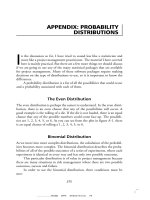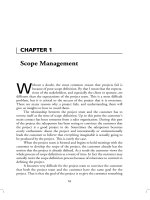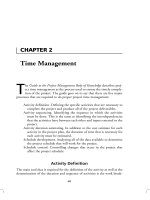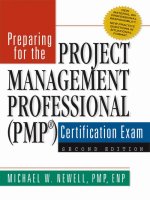The Program Management Professional PgMP® ExamPractice Test & Study Guide potx
Bạn đang xem bản rút gọn của tài liệu. Xem và tải ngay bản đầy đủ của tài liệu tại đây (3.15 MB, 428 trang )
PgMP
®
Exam
Practice Test & Study Guide
Third Edition
ESI International Project Management Series
Series Editor
J. LeRoy Ward, Executive Vice President
ESI International , Arlington, Virginia
Project Management for Healthcare
David Shirley
978-1-4398-1953-1
Managing Web Projects
Edward B. Farkas
978-1-4398-0495-7
Project Management Recipes for Success
Guy L. De Furia
978-1-4200-7824-4
A Standard for Enterprise Project Management
Michael S. Zambruski
978-1-4200-7245-7
Determining Project Requirements
Hans Jonasson
978-1-4200-4502-4
The Complete Project Management Office Handbook, Second Edition
Gerard M. Hill
978-1-4200-4680-9
PROGRAM MANAGEMENT TITLES AVAILABLE
FROM AUERBACH PUBLICATIONS, TAYLOR & FRANCIS GROUP
PgMP
®
Exam: Practice Test and Study Guide, Third Edition
Ginger Levin, and J. LeRoy Ward
ISBN: 978-1-4665-1362-4
Program Management Complexity: A Competency Model
Ginger Levin, and J. LeRoy Ward
978-1-4398-5111-1
Implementing Program Management: Templates and Form Aligned with the
Standard for Program Management—Second Edition (2008)
Ginger Levin and Allen R. Green
978-1-4398-1605-9
Other ESI International Titles Available
from Auerbach Publications, Taylor & Francis Group
PMP
®
Challenge! Fourth Edition
J. LeRoy Ward and Ginger Levin
ISBN: 978-1-8903-6740-4
PMP
®
Exam: Practice Test and Study Guide, Seventh Edition
J. LeRoy Ward
ISBN: 978-1-8903-6741-1
The Project Management Drill Book: A Self-Study Guide
Carl L. Pritchard
ISBN: 978-1-8903-6734-3
PgMP
®
Exam
Practice Test & Study Guide
Third Edition
Ginger Levin, PMP, PgMP
J. LeRoy Ward, PMP, PgMP
Boca Raton London New York
CRC Press is an imprint of the
Taylor & Francis Group, an informa business
A N A U E R B A C H B O O K
Parts of A Guide to the Project Management Body of Knowledge, 2008, are reprinted with permission of the Project Management Institute, Inc., Four
Campus Boulevard, Newtown Square, Pennsylvania 19073-3299 U.S.A., a worldwide organization advancing the state of the art in project management.
Parts of The Standard for Program Management, 2008, are reprinted with permission of the Project Management Institute, Inc., Four Campus Boulevard,
Newtown Square, Pennsylvania 19073-3299 U.S.A., a worldwide organization advancing the state of the art in project management.
“OPM3” is a trademark of the Project Management Institute, Inc., which is registered in the United States and other nations.
“PgMP” is a certification mark of the Project Management Institute, Inc., which is registered in the United States and other nations.
“PMBOK” is a trademark of the Project Management Institute, Inc., which is registered in the United States and other nations.
“PMI” is a service and trademark of the Project Management Institute, Inc., which is registered in the United States and other nations.
“PMP” is a certification mark of the Project Management Institute, Inc., which is registered in the United States and other nations.
CRC Press
Taylor & Francis Group
6000 Broken Sound Parkway NW, Suite 300
Boca Raton, FL 33487-2742
© 2012 by Taylor & Francis Group, LLC
CRC Press is an imprint of Taylor & Francis Group, an Informa business
No claim to original U.S. Government works
Version Date: 20111216
International Standard Book Number-13: 978-1-4665-1365-5 (eBook - PDF)
This book contains information obtained from authentic and highly regarded sources. Reasonable efforts have been made to publish reliable data and
information, but the author and publisher cannot assume responsibility for the validity of all materials or the consequences of their use. The authors and
publishers have attempted to trace the copyright holders of all material reproduced in this publication and apologize to copyright holders if permission
to publish in this form has not been obtained. If any copyright material has not been acknowledged please write and let us know so we may rectify in any
future reprint.
Except as permitted under U.S. Copyright Law, no part of this book may be reprinted, reproduced, transmitted, or utilized in any form by any electronic,
mechanical, or other means, now known or hereafter invented, including photocopying, microfilming, and recording, or in any information storage or
retrieval system, without written permission from the publishers.
For permission to photocopy or use material electronically from this work, please access www.copyright.com ( or contact
the Copyright Clearance Center, Inc. (CCC), 222 Rosewood Drive, Danvers, MA 01923, 978-750-8400. CCC is a not-for-profit organization that provides
licenses and registration for a variety of users. For organizations that have been granted a photocopy license by the CCC, a separate system of payment
has been arranged.
Trademark Notice: Product or corporate names may be trademarks or registered trademarks, and are used only for identification and explanation
without intent to infringe.
Visit the Taylor & Francis Web site at
and the CRC Press Web site at
v
Contents
Preface vii
Acknowledgments ix
Introduction xi
About the Authors xiii
List of Acronyms xv
Strategic Program Management 1
Initiating the Program 23
Planning the Program 41
Executing the Program 61
Controlling the Program 79
Closing the Program 97
Benefits Management 113
Stakeholder Management 131
Governance 149
Practice Test 1 167
Answer Sheet for Practice Test 1 235
Answer Key for Practice Test 1 239
Practice Test 2 277
Answer Sheet for Practice Test 2 349
Answer Key for Practice Test 2 353
Appendix: Study Matrix 389
Study Matrix—Practice Test 1 391
Study Matrix—Practice Test 2 401
References 411
vii
Preface
Based on our experience in helping people to prepare for the PMP
®
Exam,
weknow that you will have questions, such as “What topics are covered on the
exam?” and “What are the questions like?” Not surprisingly, some of the most
sought-after study aids are practice tests, which are helpful in two ways
(1) taking practice tests increases your knowledge of the kinds of questions,
phrases, terminology, and sentence construction that you will encounter on
the real exam; and (2) taking practice tests provides an opportunity for highly
concentrated study by exposing you to a breadth of program management
content generally not found in a single reference source.*
We developed this specialty publication with one simple goal in mind—that
is, to help you study for and pass the PgMP
®
certification exam. Because the
Project Management Institute (PMI
®
) does not sell past exams for prospective
certification purposes, the best option is to develop practice test questions that
are as representative as possible. And that is exactly what we have done.
This guide contains study hints, a list of exam topics, and multiple-choice
questions for each of the five domains covered in the PgMP
®
exam, according
to the Program Management Professional (PgMP
®
) Examination Content Outline
(April 2011). We have prepared 20 practice questions in each of these five
domains. For the Program Life Cycle domain, we have prepared 20 questions for
each of the five phases in the life cycle. We have also included two 170-question
representative practice tests.
As we have done in our other PgMP
®
Exam Practice Test & Study Guide books,
we have included a plainly written rationale for each correct answer along with a
supporting reference list. References are provided at the end of this study guide for
the five domains covered in the exam: Strategic Program Management, Program
Life Cycle, Benefits Management, Stakeholder Management, and Governance.
“PMP” is a certification mark of the Project Management Institute, Inc., which is registered in the United
States and other nations.
“PgMP” is a certification mark of the Project Management Institute, Inc., which is registered in the United
States and other nations.
“PMI” is a service trademark of the Project Management Institute, Inc., which is registered in the United
States and other nations.
viii ◾ Preface
The questions are scenario based, as those on the PgMP
®
exam. While some
are definition questions, they are based on a scenario.
For those who speak English as a second language (ESL), our experience
in presenting program and project management courses around the world has
shown that most of our ESL clients understand English well enough to pass
the PgMP
®
exam as long as they know the content. Nevertheless, in an effort to
avoid adding to your frustration before taking the exam, we have painstakingly
reviewed each question and answer in the practice tests to ensure that we
did not use words, terms, or phrases that could be confusing to people who
are not fluent in English. Although the language issue may concern you, and
rightfully so, the only difference between you and those who speak English
as their first language is the amount of time it takes to complete the exam.
Ifyou can grasp the content expressed in this publication, then we believe that
a few colloquialisms or ambiguous terms on the real exam ultimately will not
determine whether you pass or fail. Your subject matter knowledge will do that.
Earning the PgMP
®
certification is a prestigious accomplishment, but studying
for it should not be difficult if you use the tools available.
Good luck on the exam!
Dr. Ginger Levin, PMP, PgMP
Lighthouse Point, Florida
J. LeRoy Ward, PMP, PgMP
New York, New York
ix
Acknowledgments
We want to acknowledge the efforts of our publisher, CRC Press, and especially
that of Mr. John Wyzalek. Randy Burling, Joselyn Banks-Kyle, and the entire
CRCteam who worked tirelessly to publish this book so it would be available
according to the release of the new PgMP
®
exam from PMI
®
.
xi
Introduction
The Program Management Professional (PgMP
®
) Exam Practice Test & Study Guide
includes five sections, each of which corresponds to one of the five domains
described in the Program Management Professional (PgMP
®
) Examination Content
Outline (April 2011). Each section contains study hints, a list of major topics that
are encountered on the exam, and 20 multiple-choice practice questions complete
with an answer sheet, an answer key that includes a rationale for each correct
answer, and a bibliographic reference for further study if needed. TheProgram
Management domain is broken into five sections corresponding to the five phases
in the program life cycle as described in the Examination Content Outline. Given
the large number of questions in this domain, we have 20 multiple-choice practice
test questions for each of these five sections.
We have also included two complete practice tests, each consisting of
170questions
*
, that follow the blueprint of the real PgMP
®
exam as described
inthe Examination Content Outline. For example:
◾ 15 percent of the questions relate to strategic program management
◾ 44 percent relate to the program life cycle as subdivided as follows:
− 6% of the questions involve initiating
− 11% of the questions involve planning
− 14% of the questions involve executing
− 10% of the questions involve controlling
− 3% of the questions involve closing
◾ 11 percent relate to benefit management
◾ 16 percent relate to stakeholder management
◾ 14 percent relate to governance
To use this study guide effectively, work on one section at a time. It does not
matter which section you choose first, but we recommend that you answer the
*
Of the 170 questions on the real PgMP
®
certification exam, 20 are pretest questions and do not count
for scoring purposes. When taking the real exam, you will not know which 20 are the unscored pretest
questions, so you will need to answer each question as if it were one of the 150 to be scored. For the
practice test in this publication, we provide all 170 questions as if they were real questions; there are
nopretest questions in our practice exams, and the blueprint is applied to all 170 questions.
xii ◾ Introduction
questions in the order presented, because this order reflects the Examination
Content Outline. Start by reading the study hints, which provide useful background
on the content of the PgMP
®
exam and identify the emphasis placed on various
topics. Familiarize yourself with the major topics listed. Then, answer the practice
questions that follow, recording your answers on the answer sheet provided.
Finally, compare your answers to those in the answer key. The rationales provided
should clarify any misconceptions. For further study and clarification, consult the
bibliographic reference.
After you have finished answering the questions that follow each section,
itistime to take the practice tests. We have developed scenario questions for
each practice test. Note your answers on the sheets provided, compare your
answers to the answer key, and use your results to determine what areas you
need to study further
*
.
To make the most of this specialty publication, use it regularly. The tips listed
below will help you to get the most out of your preparation for the PgMP
®
exam:
◾ Take and retake the practice tests. Photocopy the answer sheets so that you
have a clean one to use each time you retake the practice tests.
◾ Consider convening a study group to compare and discuss your answers
with those of your colleagues. This method of study is a powerful one.
Youwill learn more from your colleagues than you ever thought possible.
◾ Make sure that you have a solid understanding of the exam topics provided
in each section.
◾ Consult our bibliography, or other sources that you have found useful, for
further independent study.
◾ Most importantly, create a study plan and stick to it. Your chances of success
increase dramatically when you set a goal and dedicate yourself to meeting it.
To further enhance your study, the two practice tests are available on-line
at o/pgmp/examhome.html. Either in this book or on the
web, the practice tests are an essential study tool created with one goal in mind:
helping you to pass your exam and become PgMP
®
certified.
*
PMI
®
grades the PgMP
®
exam by assigning each question a degree-of-difficulty factor (which is not know
to you) and a certain number of points that will be awarded if it is answered correctly. When you answer
a question correctly, the value of that correct answer may, and probably will, be different from the value
of other questions because of this “factor.” To pass the real PgMP
®
Certification Exam, a candidate must
earn a total score equal to or higher than the “cut score” of 325. We do not have a degree-of-difficulty
number for the questions in our practice tests. However, we have written every question as if it had the
higher degree of difficulty. We believe that if you can correctly answer at least 90 percent of the questions
on these practice tests, then you should be prepared to pass the real PgMP
®
Certification Exam.
xiii
About the Authors
Dr. Ginger Levin is a senior consultant and educator in portfolio, program
and project management with more than 40 years’ experience in the public
and private sectors. Her specialty areas include program management, business
development, maturity assessments, metrics, organizational change, knowledge
management, and the project management office. She is active in providing
training to others as they study for their PgMPs
®
. She is an Adjunct Professor for
the University of Wisconsin-Platteville in its master’s degree program in project
management and at SKEMA, France and RMIT University in Melbourne, Australia
in their doctoral programs in project management. Before her consulting and
teaching career, she was President of GLH, Incorporated, a woman-owned
small business in the Washigton, DC area for 15 years, specializing in project
management. Earlier, she had a career in the U.S. Government, working for
sixagencies in positions of increasing responsibility for 14 years.*
Dr. Levin is the author of Interpersonal Skills for Portfolio, Program, and Project
Managers and the coauthor of Program Management Complexity: A Competency
Model, Implementing Program Management: Templates and Forms Alignedwith
the Standard for Program Management—Second Edition (2008); Project Portfolio
Management; Metrics for Project Management; Essential People Skills forProject
Managers; Achieving Project Management Success Using Virtual Teams; The
Advanced Project Management Office: A Comprehensive Look at Function and
Implementation; People Skills for Project Managers; Business Development
Capability Maturity Model; and ESI International’s PMP
®
Challenge! She was a
major contributor to ESI’s PMP
®
Study Guide.
Dr. Levin is a member of the Project Management Institute (PMI
®
) and a frequent
speaker at PMI
®
Congresses and Chapters and the International Project Management
Association. She is certified by PMI
®
as a Project Management Professional (PMP
®
),
and a Program Management Professional (PgMP
®
), and she was the second person in
the world to earn the PgMP
®
designation. She is also certified as an Organizational
Project Management Maturity Model (OPM3
®
) Professional.
“OPM3” is a trademark of the Project Management Institute, Inc., which is registered in the United States
and other nations.
xiv ◾ About the Authors
Dr. Levin holds a doctorate in public administration from The George
Washington University, where she also received the Outstanding Dissertation
Award for her research on large organizations. She also holds a master of science
in business administration from The George Washington University and a
bachelor of business administration from Wake Forest University.
J. LeRoy Ward, ESI Executive Vice President, Product Strategy and
Management, is responsible for ESI’s worldwide product offerings and
international partnerships. His 17-year career with four U.S. federal agencies has
served to complement Mr. Ward’s delivery of project management programs to
clients around the world.
Mr. Ward has authored numerous articles and publications, including
Project Management Terms: A Working Glossary; with Ginger Levin, Program
Management Complexity: A Competency Model, PgMP
®
Exam Practice Test and
Study Guide, PMP
®
Exam Challenge! and, with Carl Pritchard, The Portable
PMP
®
Prep: Conversations on Passing the PMP
®
Exam, a nine-disc audio CD set.
A dynamic and popular speaker, Mr. Ward frequently presents on program
and project management and related topics at professional association meetings
and conferences worldwide. Since 1991, he has worked to provide the most
comprehensive guidance to project management professionals, helping them to
pass the PMP
®
Exam.
Mr. Ward holds bachelor of science and master of science degrees from
Southern Connecticut State University and a master of science degree in
technology management, with distinction, from The American University. He is a
member of numerous professional associations, including the International Project
Management Association, the American Society of Training and Development,
and the Project Management Institute (PMI
®
). He is certified by PMI
®
as a
Project Management Professional (PMP
®
No. 431) and as a Program Management
Professional (PgMP
®
), and he was one of the first to earn the PgMP
®
designation.
xv
List of Acronyms
AC: actual cost
ANCI: Annual net cash inflows
BAC: budget at completion
CEO: chief executive officer
CFO: chief financial officer
CIO: chief information officer
CMMI: Capability maturity model integration
COBOL: Common Oriented Business Language
CPI: cost performance index
CV: cost variance
EMEA: Europe, Middle East and Africa
EPMO: enterprise program management office
ESL: English as a second language
ETC: estimate to complete
EV: earned value
GAAP: Generally Accepted Accounting Principles
HVAC: heating, ventilating, and air conditioning
IP: intellectual property
IRR: internal rate of return
ISO: International Organization for Standardization
IT: information technology
KPI: key performance indicator
M&A: mergers and acquisitions
NPV: net present value
OBS: organizational breakdown structure
OPM3
®
: Organizational Project Management Maturity Model
PDA: Personal Digital Assistant
PERT: Program Evaluation and Review Technique
PgMP
®
: Program Management Professional
PMBOK
®
Guide: A Guide to the Project Management Body of Knowledge
PMI
®
: Project Management Institute
PMIS: program management information system
PMO: program management office
xvi ◾ List of Acronyms
PMP
®
: Project Management Professional
PPM: project portfolio management
PV: planned value
PWBS: program work breakdown structure
R&M: reliability and maintainability
RACI: responsible, accountable, consulted, informed
RFI: Request for Information
RFP: Request for Proposal
RFQ: Request for Quotation
ROI: return on investment
SMART: specific, measurable, actual, reliable and time-based
SME: subject matter expert
SPC: statistical process control
SPI: schedule performance index
SV: schedule variance
SWOT: strengths-weaknesses-opportunities-threats
VOC: Voice of the customer
WBS: work breakdown structure
1
Strategic Program Management
Study Hints
The Strategic Program
Management
*
questions on the PgMP
®
certification exam,
which constitute 15% of the exam or 25 questions.
These questions do not relate to any of the domains or process groups within
the Standard for Program Management—Second Edition; however, this area is
referred to often within processes to ensure that the program initially supports
and continues to support the organization’s overall strategic goals and objectives.
Before the program is chartered, this area is important to make sure the
program should be pursued in the organization. Therefore, time and attention are
needed to perform an initial assessment of the program by defining its objectives
and requirements to make sure they are in alignment with the organization’s goals
and objective. A high-level roadmap or timeline for the program also should be
part of its business case before the program is officially approved. The program’s
business case should show a mission statement to describe why the program
is important. Also, it requires justification for the funds that will be required.
Examquestions will emphasize key parts of the program’s business case.
Before the program is approved, the sponsor must identify key stakeholders
who will be involved in and/or affected by the program and consult with them
to make sure the program is one that supports organizational objectives, is
feasible, is in line with the organization’s priorities as stated in its portfolio, and is
aligned with the organization’s strategic plan. Exam questions will focus on key
stakeholders and how to best ensure their support for the program.
Specific benefits for the program also should be part of the business case and
are part of this domain even though benefits management is another domain
in the exam. Benefits are the outcomes of the program and in identifying them,
*
Please note that Strategic Program Management is not one of the Program Management Process
Groups described in The Standard for Program Management, 2nd edition (hereafter referred to as
TheStandard); however, it is one of the five domains in the Examination Content Outline (2011) that
makes up the exam. Nonetheless, a wealth of information from The Standard appears in the questions
inthis part of the exam.
2 ◾ PgMP® Exam Practice Test and Study Guide
acost-benefit analysis, market analysis, and other research should be conducted.
By doing so, a high-level scope statement can be prepared along with a high-level
benefits realization plan. It is important to keep in mind that programs are
established because through a program greater benefits can be delivered than
if the projects in the program were managed in a standalone fashion. A benefit
means an improvement to the running of the organization, and benefits can
be either tangible ones, which can be quantified, or intangible ones, which
are qualitative and more difficult to measure. Both types of benefits should be
documented and included in the program’s business case.
As well, there are more constraints when managing a program than a project,
and these constraints such as regulations, standards, sustainability, cultural
considerations, geographical considerations, politics, and ethical concerns must
be considered before a program is approved. Questions will focus on the impact
of the various constraints that will affect the program to help decision makers
decide whether or not to approve it.
Strategic program management also involves evaluating integration
opportunities, which means considering resource requirements, facilities, finances,
assets, processes, and systems in the various program activities, including the
non-project work, so they are aligned and integrated across the organization.
Once the program is approved, then the initiation process begins.
This area covers a substantial volume of material, especially since it is not
discussed as a separate chapter within the Standard for Program Management.
However, in the Standard, many of the items in this domain are in the
Pre-Program Preparations Phase. You should study the contents regarding this
phase in the Standard but recognize now it contain a far broader treatment.
Following is a list of the major topics in the Strategic Program Management
domain. Use this list to focus your study efforts on the areas that are most likely
to appear on the exam.
Strategic Program Management ◾ 3
Major Topics
Project, program, and portfolio definitions
Program management definition
Relationships between—
◾ Program management and portfolio management
◾ Program management and project management
Program factors
◾ Organizational process assets
◾ Enterprise environmental factors
◾ Enterprise external factors
Program management as part of organizational planning
◾ Aligning with organizational goals and objectives
◾ Ensuring the best mix of project investments
◾ Ensuring the best use of resources
Initial program assessment
◾ Defining objectives
◾ Identifying requirements
◾ Identifying risks
◾ Establishing a high-level roadmap
◾ Defining a program vision statement
◾ Defining a program mission statement
◾ Assessing business/organizational objectives
◾ Performing scenario analysis
◾ Performing strategic planning and analysis
Pre-Program preparations phase
◾ Phase objectives
◾ Key activities
◾ Strategic benefits of the program
◾ Plan to initiate the program
◾ Objectives and alignment with organizational goals
◾ High-level business case
◾ Program checkpoints
◾ Organizational change management
◾ Approval for program initiation
4 ◾ PgMP® Exam Practice Test and Study Guide
◾ Identification of the program sponsor
◾ Stakeholders at this stage
Benefits management and strategic program management
◾ Benefits identification
◾ Research methods to identify benefits
◾ Market analyses
◾ High-level cost/benefit analysis
◾ Initiation benefit realization plan
Program selection and approval
◾ Available resource requirements
◾ Fit with the organization’s strategic goals
◾ Benefits analysis (tangible and intangible benefits)
◾ Program risks
◾ Financial analysis indicators
◾ Organizational environment
◾ Program dependencies
◾ Cost-benefit analysis
◾ Integration opportunities
◾ Milestone schedule
◾ Stakeholder alignment
◾ Vision and mission
◾ Program deliverability
◾ Feasibility
Constraints and program objectives
◾ Regulatory and legal
◾ Social impacts
◾ Sustainability
◾ Cultural considerations
◾ Political climate
◾ Ethical
◾ Intellectual property laws and issues
Existing organizational work
Existing components
Financial environment
◾ Type of program
◾ Funding models
Strategic Program Management ◾ 5
◾ Funding goals
◾ Funding process
◾ Financial analysis
◾ Funding methods
◾ Financial benefits
◾ Financial integration opportunities
◾ Funding authorization
Strategic Program Management ◾ 7
Practice Questions
INSTRUCTIONS: Note the most suitable answer for each multiple-choice
question in the appropriate space on the answer sheet.
1. Assume you are working for an organization, ABC, which has about
500people in it. Recently, your executives attended a one-day training
program that presented an overview of portfolio, program, and project
management. When the CEO, CFO, and CIO returned from this session,
you were tasked to provide a list of all of the projects under way in the
organization for their review. You had received your PgMP
®
, based on your
work in a previous organization (XYX), and also your PMP
®
. Two other
people in ABC have PMPs
®
, but you are the only person certified as a
program manager. When you reviewed all the projects before giving the list
to the executive team, you recommended to them that some of the multiple
projects under way be managed as a program. This is because—
a. Deliverables are independent
b. A collective capability is delivered
c. Resource constraints affect projects
d. Risk planning activities are comparable
2. You met with the members of the Executive team in your company ABC.
They were impressed with your knowledge of program management, and
since they had attended the one-day seminar, they told you they wanted to
make sure every project under way, and also every program they set up,
supported the organization’s strategic goals. You explained in your previous
company, XYZ, that programs were set up because they could link projects
in various ways, one of which is when—
a. Changes in organizational direction affect project work and relationships
to other projects
b. Independent benefits among the projects are detailed in the benefits
measurement plan
c. Different clients, suppliers, and technologies are included in the project
d. Discrete pacing of the projects affects the program
8 ◾ PgMP® Exam Practice Test and Study Guide
3. When you worked previously in company XYZ, considered to be one of
the first organizations to set itself up as one that is project based and also
considered projects and programs to be strategic assets to the organization,
you pointed out to the executives in your current company, ABC, as they
are beginning this initiative now to manage multiple, related projects as a
program that in terms of the relationship between ABC’s organization, and
the program, programs are part of the—
a. Mobilization process
b. Strategic objectives
c. Strategic options
d. Portfolio
4. However, as ABC moves to set up programs, this means it will be a major
culture change in the organization as the people are more used to working
on projects. The Executive Team learned at its one-day seminar that each
program must have a defined list of its expected outcomes and resulting
benefits, and a focus on benefit management is necessary for effective
program management. Benefit management will be a new change for
ABCas no one has identified benefits from projects in the past. Since each
program has this emphasis on outcomes to be expected and benefits to be
realized, itis best accomplished through—
a. The Program Governance Board
b. The program sponsor
c. Portfolio management
d. The customer
5. You are one of many project managers working on the new plasma
screendevelopment program. Your project has not yet started, but the
program manager is anxious to have it begin because the program is
running behind schedule. But before you can receive the go-ahead to start,
it is necessaryto—
a. Create a schedule
b. Define the expected benefits in the business case
c. Consult with key stakeholders to understand their requirements
d. Conduct a kickoff meeting to gather lessons learned from previous projects
Strategic Program Management ◾ 9
6. Assume you are the program sponsor for this new program on the new
plasma screen development to replace all existing LCD screens and enhance
plasma’s screens so they can be viewed in 4-D. Before you received
approval for this program, you performed an initial program assessment.
You wanted to define your program’s objectives, requirements, and risks.
Focusing on requirements, you decided one way to proceed in order to
make sure your stakeholders were involved in this process from the start
and also to gain their support for this program was to—
a. Use focus groups
b. Consult with experts for suggestions based on work on previous programs
c. Conduct a customer acceptance review
d. Define a high-level program roadmap
7. Assume you are working in a Fortune 500 company. Recently, your company
hired an outside OPM3
®
Certified Professional to conduct an Organizational
Project Management Maturity Assessment of its program management
practices in terms of the standardize, measure, control, and continuous
improvement areas. As the company has been working in program
management for some time and has a defined methodology in place that is
regularly followed, you were not surprised that it scored extremely high in
terms of the number of Best Practices from this assessment. As part of your
company’s program management methodology, there is a formal selection
process in place. This is characteristic of an organization that—
a. Has a program governance structure
b. Has a program management office (PMO)
c. Has a project and program management career path
d. Is more mature in program management
8. As you work to prepare the business case for the new plasma screen program,
you recognize it is essential to identify potential benefits that will accrue
from establishing this program. You have assembled a team of stakeholders
and plan to interview them for their opinions on the possible benefits, both
tangible and intangible. Your goal is to present to your selection committee
in your business case specific, measurable benefits that you believe can be
delivered and controlled. You also want the people who will be involved in
your program to recognize these benefits and their importance . Therefore,
itis important that you make sure that once approval is received that—
a. You meet regularly with stakeholders to keep them informed about the
progress of your program
b. Your benefit realization plan is integrated with your program
management plan
c. Every member of your team participates in the development of the
benefits realization plan and signs off on it
d. All the intangible benefits you identified are now quantified









